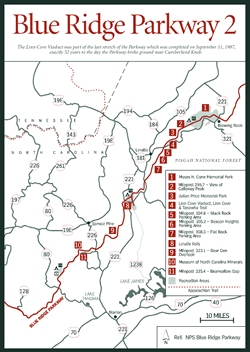 The
Blue Ridge Parkway in the Black Mountains
The
Blue Ridge Parkway in the Black Mountains  The
Blue Ridge Parkway in the Black Mountains
The
Blue Ridge Parkway in the Black Mountains [Fig. 11] Breathtaking vistas, waterfalls, hiking trails, trout lakes, nature museums, craft heritage trails, and tunnels are plentiful along this section of the Parkway. So full of wonders, in fact, it hosts four of the seven National Park Service Visitor Centers in North Carolina: Cone Memorial Park [Fig. 11(1)], Linn Cove [Fig. 11(4)], Linville Falls [Fig. 11(8)], and the Museum of North Carolina Minerals Visitor Center [Fig. 11(10)].
Many of the larger parks and trails along the Parkway are covered below, but all of the overlooks are worth a stop, too, such as the View of Calloway Peak at milepost 299.7 [Fig. 11(2)]. In addition to offering a peek at the highest point on Grandfather Mountain (Calloway Peak is Grandfather's nose), the overlook includes two "whaleback" rock outcrops. Geologists call them whalebacks because of the humpbacked shape that develops after centuries of erosion by water, ice, and wind.
At Stack Rock Parking Area, milepost 304.8 [Fig. 11(5)], a short walk along the Tanawha Trail leads to a view of Stack Rock, a natural formation that, as the name implies, appears to be a stack of large rocks. The Beacon Heights parking area, milepost 305.2, offers a short, leg-stretching walk through rhododendron (Rhododendron catawbiense and maximum), mountain laurel (Kalmia latifolia), hemlock (Tsuga canadensis), and a host of wildflowers such as teaberry (Gaultheria procumens), speckled wood lily (Clintonia umbellulata), and wild lily of the valley (Convallaria montana). The view from Beacon Heights [Fig. 11(6)] spans across the Linville Falls area, where distinctive Table Rock and Hawksbill Mountain stand out on the horizon.
The effect of strong winds is evident at the Flat Rock Parking Area, milepost 308.3 [Fig. 11(7)], elevation 3,948 feet. Trees here appear to be pruned, but that is actually the handiwork of whipping winds, some clocked at close to 100 miles per hour. The moderately easy, .7-mile, self-guiding loop trail features information describing the rich flora found along the Parkway and passes the Flat Rock, a quartzite outcropping interwoven with white quartz veins formed when still-molten quartz filled cracks between faster cooling rock. Farther south, Bear Den Overlook, milepost 323.1 [Fig. 11(9)], and Bearwallow Gap, milepost 335.4 [Fig. 11(11)], are just two Parkway stops recognizing an important mountain resident. As many as 100,000 black bears (Ursus americanus) once lived in North Carolina; today only 4,000 bears live throughout the state because of declining habitat and poaching. Black bears are very shy and nonaggressive, but they occasionally wander into populated areas in search of food. In case of an encounter, visitors are advised to stop and slowly back away.
While the entire length of the Blue Ridge Parkway is an engineering marvel, the five tunnels and renowned Linn Cove Viaduct [Fig. 11(4)] in this section are especially noteworthy. As a result of local concern for the environment and the Parkway's commitment to the protection of the ecology, construction took much longer than normal. The Linn Cove Viaduct was part of the last stretch of the Parkway to be completed on September 11, 1987, exactly 52 years to the day the Parkway broke ground near Cumberland Knob.